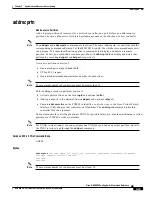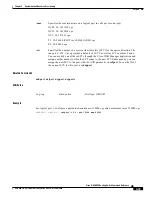
3-30
Cisco MGX 8850 Routing Switch Command Reference
Release 2.0, Part Number 78-10467-04 Rev C0, October 2001
Chapter 3
Equipment and Resource Provisioning
cnfln
Syntax for T3/E3 Line
cnfln -ds3 <bay.line>
-lt <LineType>
-len <LineLength>
-oof <LineOOFCriteria>
-cb <LineAIScBitsCheck>
-rfeac <LineRcvFEACValidation>
-clk <clkSource>
Syntax Description (T3/E3)
All parameters are keyword driven. Therefore, the order that you enter them does not matter.
-ds3
Identifies the bay (1 or 2) and the number of the line. The format for LineNum is
bay.line. The line number is from 1 to the highest numbered line on the back card. For
the range of line numbers on specific AXSM models, see
Table 3-1
.
-lt
Specifies the type of T3 line. The possible value for a T3 LineType is 1 or 2:
•
1 = ds3cbitadm
•
2 = ds3cbitplcp
-len
The length of the line in meters. The range for LineLength is 1–64000.
-oof
A number that specifies the threshold for triggering an Out Of Frame condition. The
possible value for LineOOFCriteria is 1 or 2 and has the following significance:
•
1 = 3 out of 8
An Out Of Frame condition is declared if at least 3 of 8 framing bits are in error.
•
2 = 3 out of 16
An Out Of Frame condition is declared if at least 3 of 16 framing bits are in error.
-cb
A number that determines whether the node checks the C-bit status in response to AIS
status. The value for LineAIScBitsCheck can be 1 or 2 and has the following
significance:
•
1 = check the C-bit
•
2 = ignore the C-bit
-rfeac
Value to set FEAC (far-end alarm and control) code validation criteria. The value for
LineRcvFEACValidation can be 1 or 2 and has the following significance:
•
1 = 4 out of 5. A valid FEAC code is declared if 4 of 5 codes match.
•
2 = 8 out of 10
A valid FEAC code is declared when 8 of 10 codes match.
-clk
A number that determines whether the transmit clock comes from the backplane
(“local timing”) or the receive clock on the line (“looped timing”). The value for
clockSource can be 1 or 2 and has the following significance:
1 = loop timing: receive clock is re-directed on the back card to be the transmit clock.
2 = local timing: (default) clock from the backplane is the transmit clock.
















































